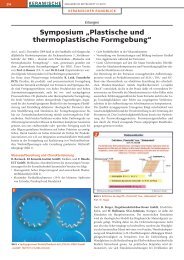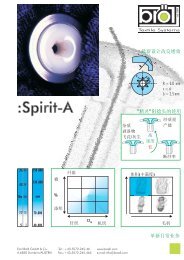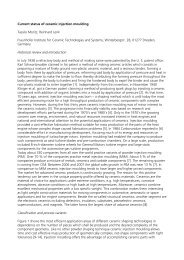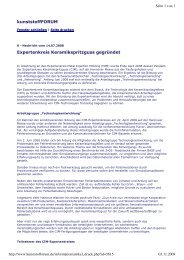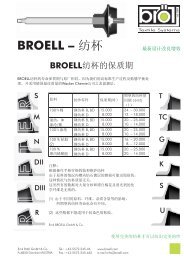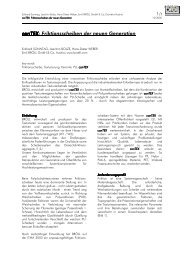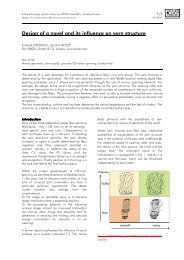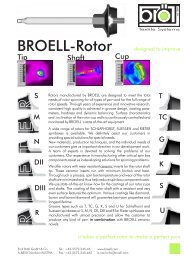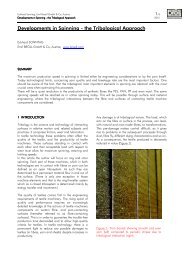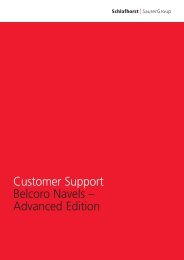Ad1-Internetartikel english
Ad1-Internetartikel english
Ad1-Internetartikel english
You also want an ePaper? Increase the reach of your titles
YUMPU automatically turns print PDFs into web optimized ePapers that Google loves.
Eckhard Sonntag, Bröll GmbH&Co, Dornbirn/Austria 5/5<br />
Navel – Surface Characteristics as the Decisive Factor for Superior Quality in Rotor Spinning<br />
Figure 6: A pore in the ceramic structure and<br />
respective fibre dimensions<br />
Ceramic Ceramic wear wear vs. vs. textile textile characteristics<br />
characteristics<br />
The life cycle of a navel varies according to<br />
stresses imposed on it as well as to the<br />
requirements of the spinner or downstream<br />
processor. Usually the life cycle of navels is 6 to<br />
48 months. Extreme examples just underpin<br />
demanding quality standards. The rotor yarn is<br />
located in the region of the navel for 5 to 15 turns<br />
of the rotor . Independent of delivery speed a yarn<br />
touches every 1 to 2 mm the same region of the<br />
navel surface or touches the same potential<br />
defects. If the type of wear is purely<br />
transcrystalline (smooth wear through the grain)<br />
the navel will act as favourably as a steel navel. If<br />
wear is intercrystalline, microfractures will appear<br />
around sharp-edged grain boundaries – resulting<br />
in at least a significant increase in Staff (fly) values<br />
as well as mostly a loss in yarn tenacity.<br />
Figure 7: Time dependence of Staff (fly) values as<br />
indicator for wear of the navel<br />
Variations from position to position can be limited<br />
by a more precise positioning between metal<br />
holder and ceramic navel. This is where another<br />
development by Broell Corporation comes in: the<br />
ceramic press fit, as it guarantees the highest<br />
possible centering not only between ceramic<br />
navel and holder but simultaneously between face<br />
plate and rotor.<br />
As a positive secondary effect press fit enhances<br />
thermal conductivity of ceramics and holder.<br />
Moreover press fit does not need any thermal<br />
isolating glue thereby eliminating the risk of glue<br />
residue sticking on the navel or the flying out of<br />
the navel into the rotor itself. Finally, at the same<br />
time the procedure of pressing acts as a quality<br />
gate as flawed ceramics do not pass this stage.<br />
Summary Summary and and and conclusion<br />
conclusion<br />
The differences between alumina ceramics are as<br />
diverse as they are for steel. Number and size of<br />
pores detected on a surface of a navel indicate<br />
the level of achieved density of the alumina<br />
structure. The purity of the ceramic determines the<br />
strength of grain boundaries. The smaller the<br />
grain the more ductile is the ceramic. Taking<br />
these parameters into account from the early<br />
stages of the development process is the best way<br />
to achieve high production navels for OE<br />
spinning: navels that are characterized by high<br />
resistance to wear combined with favourable<br />
behaviour in terms of development of wear, a<br />
lower yarn friction while simultaneously providing<br />
higher thermal conductivity. By this means proven<br />
increases in productivity of 5 – 15 % are<br />
attainable. Top economic efficiency with<br />
microfibers, from high productivity of OE yarns, is<br />
achievable by applying such a highly advanced<br />
navel design together with attaining the highest<br />
possible rotation speed of rotors when processing<br />
man-made fibers.<br />
In the context of “nanosizing” more positive<br />
characteristics of ceramics can be revealed and<br />
benefited from in the future.<br />
Sources Sources<br />
Sources<br />
[1] Sonntag, E.: Developments in Spinning –<br />
the Tribological Approach, Tribology 2000 -Plus,<br />
12th Int. Trib.-Colloquium, Jan.11-13th, 2000,<br />
Vol.3, 1565-1569 as well as www.broell.com<br />
[2] Gräfen, H.: Lexikon der Werkstofftechnik,<br />
VDI-Verlag, Düsseldorf 1991<br />
[3] Rohde, M.; Schulz,B.: The Effect of the<br />
Exposure to Different Irradiation Sources on the<br />
Thermal Conductivity of Al203, Journal Nuclear<br />
Materials 173 (1990), S.289<br />
[4] Touloukian, Y.: Thermophysical<br />
Properties of Matter, Vol.2, Plenum Press, N.Y.,<br />
1970<br />
more infos: e.sonntag@broell.com<br />
Emil Emil Bröll Bröll GmbH GmbH GmbH &<br />
&<br />
Co. Co. Holzstr.1 D-<br />
73650 Winterbach



